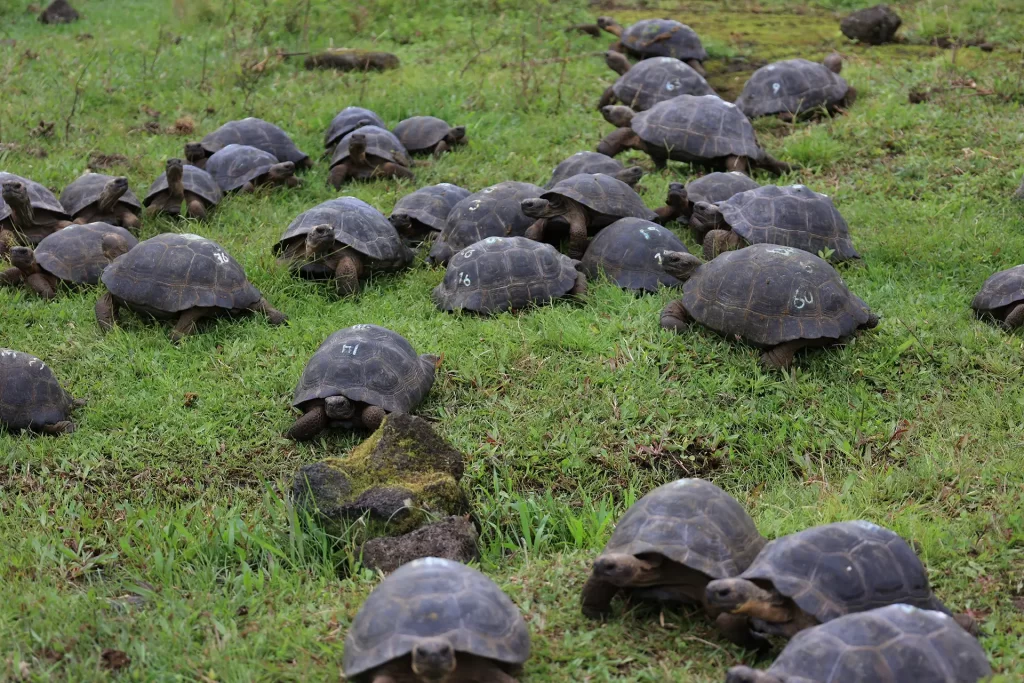The Galapagos Conservancy team successfully conducted 14 conservation expeditions on six different islands last year as part of the Iniciativa Galapagos Program, a collaborative effort with Galapagos National Park Directorate. The team visited the serene beaches in Santa Cruz, the interior of Espanola Island and the interior of Fernandina Island. They also explored the clear waters of Isabela Island. Each field mission had its own challenges, but the goal was the same: conserve the unique species of the Galapagos Archipelago.
Over 500 juvenile giant turtles hatched in captivity and raised there were the focus of many expeditions. In March, an expedition to Espanola Island involved the repatriation 86 juvenile Chelonoidis Hoodensis tortoises. This was a critical step in the tortoise’s reoccupation of this island. In the 1960s only 14 individuals remained of this species. The tortoise populations has grown to approximately 3,000 individuals through efforts like those made during this expedition to repatriate juvenile tortoises that were bred in captivity. The captive breeding program was closed due to its success. There are still 250 tortoises held in captivity on Santa Cruz Island at the Breeding Center, waiting for the perfect time to be released on an upcoming expedition to Espanola Island.
The 2023 expeditions were primarily focused on conducting the first comprehensive census of ten populations of giant turtles living in the southern volcanoes Isabela Island. The preliminary data shows that the Chelonoidis Vicina population, which lives on Cerro Azul Volcano, has a slight recover. It is estimated to be 5,275 individuals. Chelonoidis Guntheri however, only lives on Sierra Negra Volcano. The situation is still worrying. The team estimated that there were only 704 individuals in the population. These expeditions revealed critical insights about the challenges facing both species and what they can do to assist them in recovering.

©Galápagos Conservancy
The team also conducted a significant expedition to the northern part of Isabela Island where they searched extensively for the last remaining pink iguanas Conolophus Marthae in their restricted habitat on top of Wolf Volcano. They made an important discovery during the expedition: two juvenile pink iguanas and one subadult were seen together for the first. This discovery is amazing because introduced species, mostly cats, are a serious threat to the juvenile pink iguanas. The observations show that the iguanas reproduce, which suggests that management efforts could be effective. This is an important finding, given that the pink iguana population is only estimated at 250 to 300 individuals.
Espanola Island has been the focal point of several expeditions aimed at protecting the Galapagos Albatross, PHOEBASTRIA irrorata. This endemic species is emblematic of the archipelago and its entire global population nests on this island. They spent several weeks in June and August counting albatrosses on the entire island to better understand the size, distribution and trend of the population. Data from previous years indicated a nesting population of around 35,000 adults, but numbers on the island decreased substantially in 2023. This was likely due to El Nino, conditions that prevailed during 2023 and are now receding, allowing a population recovery in 2024.

©Galápagos Conservancy
A second expedition to Santiago Island was a decisive step in helping the endangered “Darwin tortoise”, or Chelonoidis Darwini. Only 1,000 to 1,200 of these tortoises remain. The International Union for Conservation of Nature has classified these tortoises as “Critically endangered” since 2015. This indicates the need for immediate interventions to ensure their survival. The team collected 169 tortoise eggs and 112 hatchlings in November 2023. They were then transported back by helicopter to the Breeding & Rearing Center, Santa Cruz Island. There they will be raised and reintroduced within five years.
The fourteen expeditions of the team in 2023 were a huge effort and logistical feat. The 14 expeditions of the team in 2023 were a huge effort and logistical feat. They also represented the ongoing, earnest efforts of the Iniciativa Galapagos Program to protect the wildlife of Galapagos at the most remote and difficult to access areas. They are committed to protecting the Galapagos ecosystems and they could not do it without your support. They are working together to preserve these natural treasures in Galapagos and ensure their protection and recovery.

©Galápagos Conservancy



